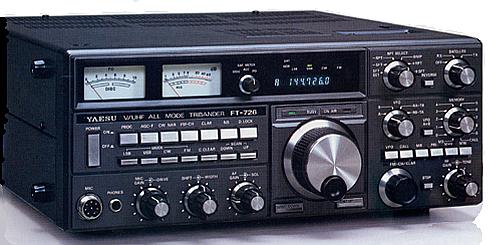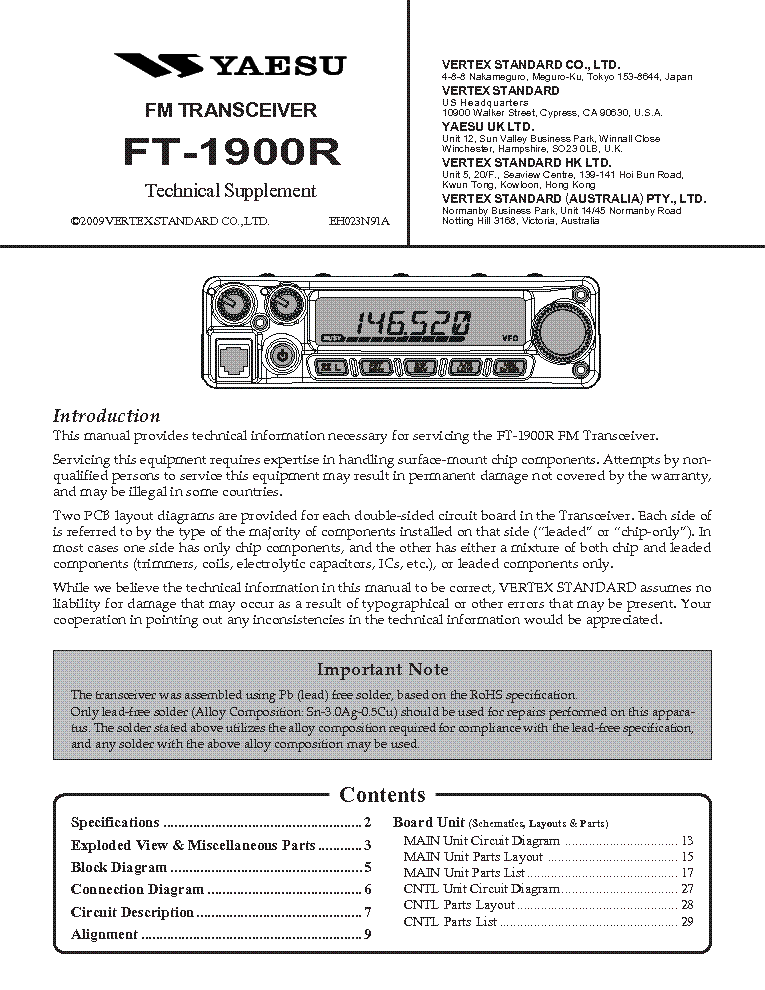
As with all of my modifications, you should have the FT1000 Service Manual. The following mod is accomplished with just two resistors. Here's the compete instructions: 1) Remove the TOP COVER (8 screws) and the POWER AMP shroud (6 screws) on the back of the radio. 2) Locate thermistor TH7602 where it solders into the PS UNIT Board. Note: this modification was posted by Barry Williams KD5VC to the Yaesu reflector The FT1000D comes equipped with additions including I.F. Filters for the 455khz. The narrowest of these has a 500hz. Bandwidth, but no matching filter for the 250hz. Bandwidth for the 455khz.
This modification requires the addition of a switching diode (1N4148, 1N918 etc.) between the select line on the 250hz filter spot and the 500hz. filter.
First access the filters on the I.F. board, and clip the diode as indicated for the installation of the 250hz. filter in the manual. Then remove the 500hz. filter, note that the I.F. filter position for the 500hz. filter is the second from the front of the radio.
- User Manual: Pdf YAESU-FT-1000-Service-manual. Open the PDF directly: View PDF. Page Count: 211.
- Download YAESU FT1000 service manual & repair info for electronics experts. Service manuals, schematics, eproms for electrical technicians. This site helps you to save the Earth from electronic waste! Type: (PDF) Size 2.0 MB. Category OTHER SERVICE MANUAL.
- Yaesu FT-1000D (FT 1000 D FT1000D) Rx Ant Mod: The goalTo modify the FT-1000D ( or FT-1000 w/ BPF option) for independent operation of both receivers on unrelated bands and/or modes using the main antenna and retain the ability to use a Beverage antenna on the RX ANT jack.
Then solder the diode between the cathode end of the 250hz. select diode, and the cathode end of the diode under the 500hz. filter. This diode should be oriented with the cathode toward the 250hz. select diode's cathode end.
Now when the 250hz. third I.F. control pulls the select line low, the new diode will pull the 500hz. filter select line low, selecting that filter in place of the 2.4khz. filter.
When you finish this modification you will note that the 500hz. filter reduces the wideband noise, and the 'Width' control works when the 250hz. filter is selected.
Because of the mismatch in the filter bandwidths, the first few detents on the width control act as an I.F. shift, when the 500hz. filter is offset enough to 'catch up' with the bandwidth of the 250hz. filter, the action changes to a bandwidth control.
On my radio, the first three detents act as an I.F. shift, and the next three reduce the bandwidth to under 100hz.
Important Addendum to KD5VC 250Hz Filter Mod Nintendo 64 games online no.
In KD5VC's mod, the references to connecting a new diode between the cathodes of the 250Hz and 500Hz select diodes means to connect to the PCB solder pads that the cut diodes' cathodes were formerly connected to, not to the cut flying leads on the actual diodes themselves! The 250Hz select diode is D2045 and the 500Hz select diode is D2046. Both are clearly marked on the PCB.
This mod also appeared in QST, Jun 96, p.70 (with the same ambiguous narrative). I have installed it and it works very well. An FT-1000D does not ship with the 250Hz 3rd IF filter- it is an option. This circuit trick can save you the cost of a crystal filter- with a 5 cent diode- while still greatly improving CW performance at 250Hz BW over the factory stock configuration. For FT-1000 owners: note that the mod assumes that the 250Hz 2nd IF filter is already installed. The purpose here is to cascade the 500Hz 3rd If filter with the 250Hz 2nd IF filter.
I found that the HMM-Y mic output was understandably lower in level than the stock electret based mic. In order to accommodate this I performed surgery on my FT-100D, changing R1334 (SMT resistor) from 10k Ohms to 1k, thereby increasing the mic pre-amp gain by about 14 dB.(I don't recommend anyone doing this unless they have an SMT soldering station, good SMT experience and very steady hands. You can easily ruin the PC board).
I also experimented with 'full range' and 'DX' elements in the Heil mic, the 100D processor, the MIC DSP settings and the carrier offset controls. Using a monitor receiver with the 100D running into a dummy load I converged on the best setup.
Very simple.
For rag chewing the 'full range' element gets great audio reports. I brought the TX carrier injection up to +200 Hz which removed some excess bass response. No MIC DSP is used (i.e. setting = OFF). Processor is off. MIC GAIN setting is around 50 to 60 with the Heil mic and the FT-100D preamp 14 dB mod. Before increasing the preamp gain I had to speak loudly with the MIC GAIN set to 100; no good!
Yaesu Ft1000d Service Manual
So my search for decent 100D transmit audio is finally over, after several years of fussing around with the stock mic, trying a couple modifications on the stock mic and trying every imaginable combination of settings on the rig (and spending about $100 for the Heil mic and AD-100 adapter).
Yaesu Ft-1000d Service Manual

Yaesu Ft 1000d For Sale
For contesting I think the DX element or perhaps just the processor with the 'full range' element will work well. The DX element has an annoying quality to it, but I suppose you want that when you're trying to scream through a pileup.